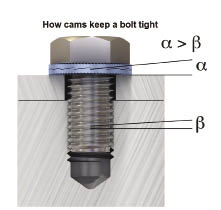Hidenori Araki, Nord-Lock, www.nord-lock.com

The angle alpha on the washer cams
exceeds the thread pitch angle beta, so vibration cannot loosen the tightened bolt.
Wind turbines are home to a range of critical bolting applications. From the blades, rotor disc, the nacelle, all the way down through the tower and the foundation, bolted joints are major considerations. Hence, an effective bolt securing system is critical for safe and efficient operation of these massive feats of engineering.
Because many wind turbine joints are subject to vibration, regular maintenance is required to keep the nuts and bolts tight. This means lugging heavy, high-powered tools up a tall tower, more often than anyone would like.
Another factor affecting wind-turbine-bolted joints is settlement. It is the loss of preload due to the settling of thick surface coatings or composite materials, and other design challenges. Surface coatings protect bolts and material from corrosion while composite materials are used for their impressive strength-to-weight ratios. These and other conditions can play a role in negatively affecting bolted joints. So it’s no surprise that an improperly tightened joint, or one that no longer holds the load, can result in damaged equipment and additional maintenance costs.

After tightening the fastener (left) the slightly conical washers flatten and the serrations engage the contact surfaces (middle). Because the cam angle (α) is greater than the thread pitch (ß), the wedge-locking effect prevents rotation of the fastener. After some time, the joint settles and the fastener sinks into the surface material. The washers immediately deflect and their spring effect (Fs) counteracts the slackening movement or elongation (ΔL) of the bolt, thereby preventing the joint’s loss of preload.
One option used for these applications is a multifunctional wedge-locking washer, the X-series from Nord-Lock. This bolt-securing system consists of a pair of pre-assembled washers that are installed cam-face to cam-face. Tightening the bolt or nut lets the teeth grip and seat the mating surfaces. The washers are locked in place, allowing movement only across the face of the cams. The washers have a cam angle α, which is greater than the thread pitch ß. So any attempt of the bolt-nut assembly to rotate loose is blocked by the wedge effect of the cams.
To deal with both the spontaneous bolt loosening (from vibration and dynamic loads), and joint settlement and relaxation found in wind-turbine bolting, this next generation of washers introduces a spring effect from a slight conical profile. The cams provide the wedge effect that prevents bolt loosening while the spring effect compensates for the loss of preload due to settlement.

The graphs show the clamping force changing with time for four different fasteners and washers. Nord-Lock X-series performs better than alternatives when compensating for slackening in static conditions and in preventing rotation of the fastener when the joint is exposed to vibration in the dynamic phase. The graphs also show that all bolted joints have a functional preload range in which the joint is safe. Problems start as soon as the preload falls outside the functional range. If the preload is too high, materials yield. If it is too low, the bolted parts separate or slide.
To see how different products function in various circumstances, look at how preload in a bolted joint changes over time. The graphs (left) illustrate the performance of traditional bolts used with composite material joints. Nord-Lock classifies the process in two phases: a static phase in which settlement is measured and a dynamic phase when vibration is added. The results compare how four designs counteract slackening and handle vibration.
X-series washers keep the joint tight, thus eliminating the problems associated with loose bolts common in critical wind turbine bolting applications and the need for frequent maintenance checks. Furthermore, the device reduces labor costs, makes the job easier for workers, and makes the turbine more profitable for its operators. WPE
Filed Under: Featured, News, O&M






Hello William, the testing was conducted using the Junker vibration test per DIN 65151 which is considered the most severe vibration test for bolted connections. Sorry for the delay in response!
Hello! May I ask the type of vibration testing procedure that was used? Thank You!